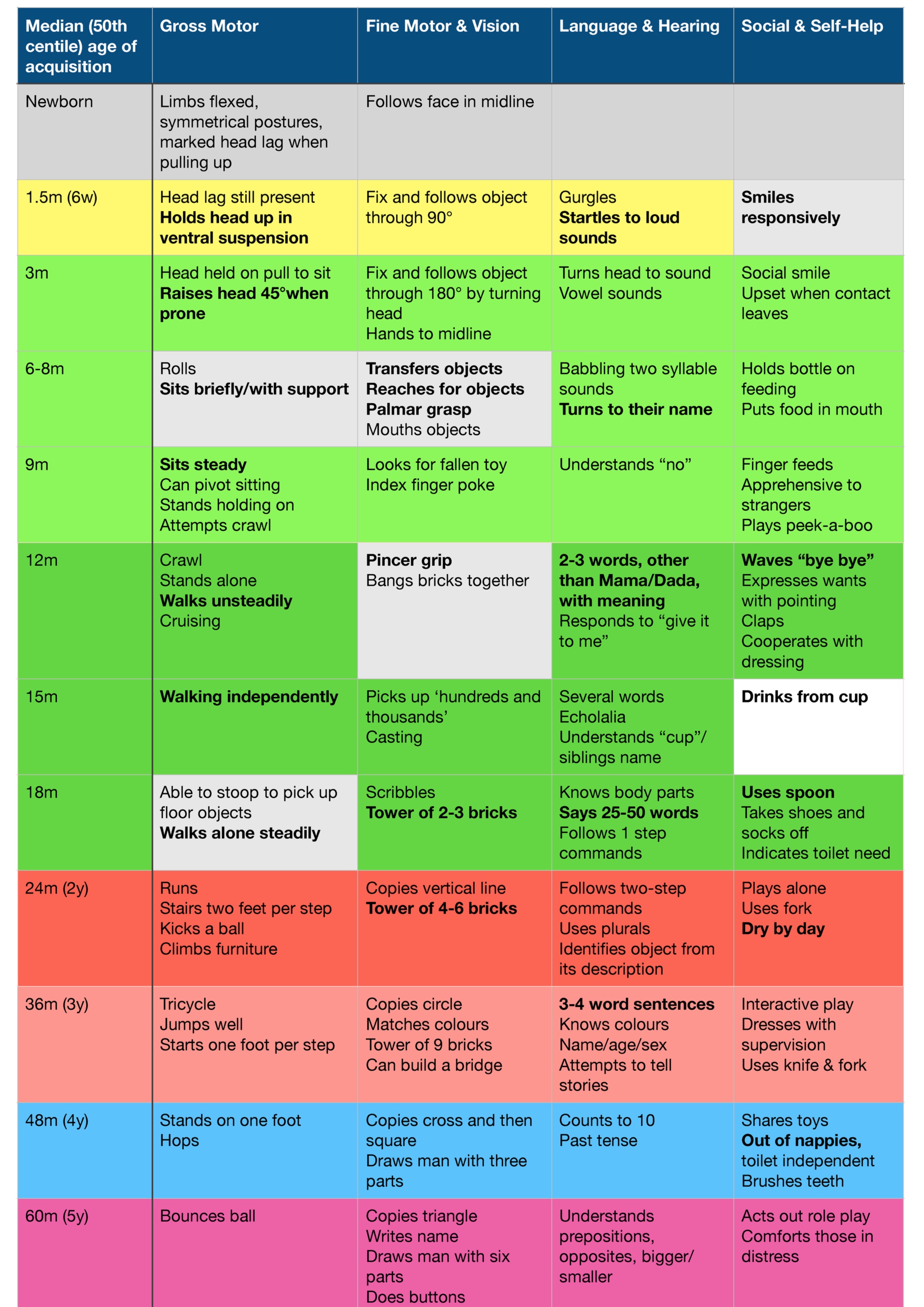Developmental milestones
Child’s developmental skills described within 4 domains:
Gross motor skills
Fine motor skills and vision
Language and Hearing
Social & Self-Help
5-10% children have developmental delay in at least one domain.
Speech delay affects 15-20% of children. Consider referral to paediatric audiology as well as SALT (speech and language therapy)
Global developmental delay: significant functional delay in two or more domains. GDD affects 1-3% of children
Development coordinator disorder (DCD): impairment of motor coordination (dyspraxia), affects 10% of children.
If mild, and not limiting the child’s academic achievement or daily living, and no other domains impaired, then paediatric referral is not often required.
Autism: combination of repetitive motor mannerisms, poor language skills, poor social interaction, reduced eye contact, lack of social awareness, preoccupation with interests, and issues with personal space
Regression or delay in social milestones may indicate autism or child abuse
Newborn Hearing test: automated otoacoustic emissions (AOAE) test is offered to all neonates
6w Neonatal review: each child has an early neonatal (6w weeks) medical review with a GP.
Vision: test for red reflex in each eye, ability to fix and follow, response to light
Hearing: test for startle/response to sound
Pre-school visual screen: each child should be screened for visual impairment age 4-5y (orthoptic-led service) to detect amblyopia, refractive error and strabismus.
Testing is carried out by an optometrist or suitably trained school nurse.
Prematurity: need to correct for gestational age if premature; correction required for chronological and ‘biological age’ for up to 1yr-18m.
Significantly premature babies are usually already under child development centre follow up.
Developmental Red Flags (requiring paediatric referral)
Gross motor skills
Unable to hold head on ventral suspension by 3m
Unable to support head when prone by 6m
Unable to sit by 8-9m
No attempt to crawl/bottom shuffle by 12m
Not walking by 18m
(check creatine kinase)
Not running by 2.5y
Persistent toe walking
Persistently low muscle tone or floppiness
Asymmetry of movements +/- increased muscle tone
Fine motor & vision
Not able to fix and follow an object/face or poor eye contact at ANY AGE (+ refer to ophthalmology)
Unable to hold object(palmar grasp) or reach for objects by 6m
Unable to transfer between hands by 9m
Not able to use pincer grip by 12m
Early asymmetry of hand function (hand preference) before 1 year
Language & Hearing
No startle to loud sounds by 6w
Not turning to rattle sound by 6m
No speech by 15-18m (+ refer to paediatric audiology)
Hearing loss (+ refer to paediatric audiology)
Social & Self-help
Not able to smile by 6w
Not able to point a objects to share interest with others by 2y
No interactive play by 3y
Approximate times for the development of some gross motor skills are:
Head lag evident – when pulled to sitting: 0–6 weeks
Rolls over: 8–18 weeks
Sits alone: 18–30 weeks
Pulls self up to stand: 6–10 months
Walks holding furniture: 7–13 months
Walks alone: 11–14 months
Jumps with both feet together: 12–20 months
Kicks ball: 14–24 months
Hops, skips: 34–60 months
Skip on both feet: 72 months
Assessment
History
History of complaint: single or multiple domains, duration, pattern of symptoms dependent on home/outside home/school environment, attainment of other developmental milestones
History of pregnancy and birth and any antenatal/perinatal complications
Past medical history
Family history, (any siblings with similar developmental issues)
Social history (any safeguarding concerns)
Examination
Ensure child’s weight, height and head circumference is plotted
Any obvious dysmorphic features or microcephaly
Conduct full physical examination including cardiac, respiratory, neurological, musculoskeletal and ENT assessment
Differential diagnosis for delayed milestones
Cerebral palsy
Muscular dystrophy
Neuromuscular and neurocutaneous disorder
Genetic: chromosomal, inborn errors of metabolism, Down’s, Fragile X syndrome
Prenatal e.g. congenital intrauterine infection or maternal drug/alcohol use
Prematurity, HIE
Child abuse, particularly neglect
Idiopathic (Isolated motor delay- accounts for majority of delay in walking)

